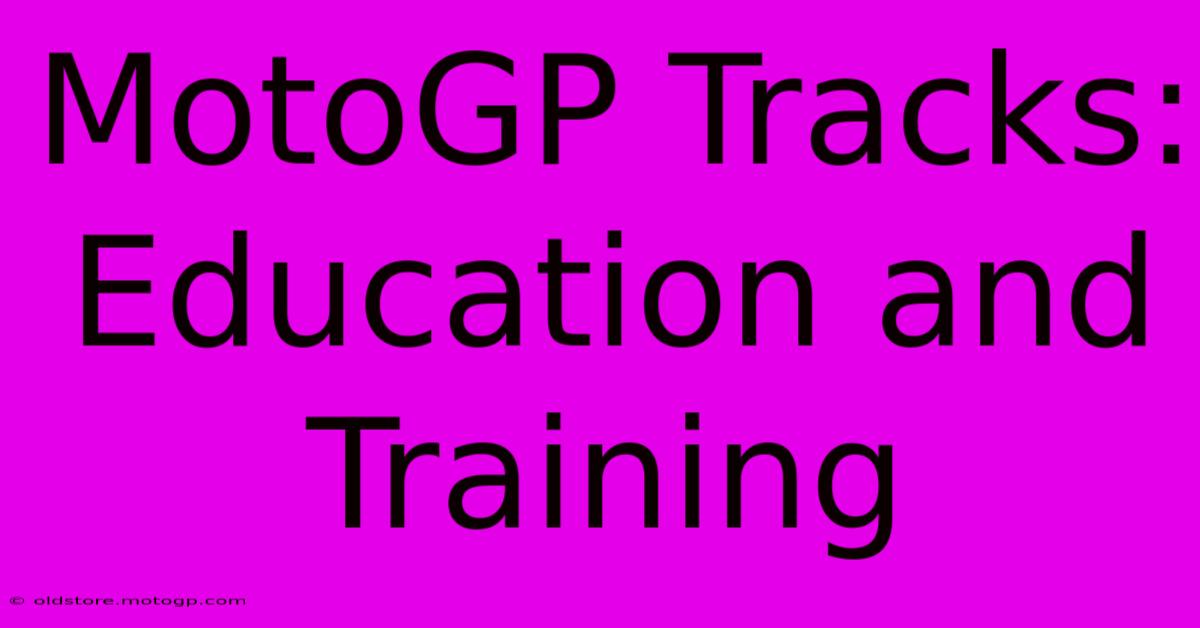MotoGP Tracks: Education And Training

Table of Contents
MotoGP Tracks: Education and Training
For aspiring MotoGP racers, understanding the intricacies of different tracks is paramount. It's not just about speed; it's about precision, strategy, and adaptation. This article delves into how MotoGP tracks serve as crucial educational and training grounds, shaping future champions.
The Classroom of Champions: Learning from the Circuit
MotoGP tracks aren't merely racing venues; they are dynamic classrooms. Each circuit presents a unique set of challenges, demanding riders to master diverse skills. This learning process involves several key aspects:
1. Mastering Track Dynamics:
Each track possesses its own distinct characteristics:
- Corner types: From sweeping high-speed bends to tight, technical hairpin turns, riders must adapt their riding style and braking points. Tracks like Mugello, known for its fast flowing corners, demand different techniques than the twisty, technical circuits of Assen.
- Elevation changes: Hills, dips, and blind crests require precise throttle control and impeccable bike handling. The elevation changes at circuits like Sepang demand precise rider input and anticipation.
- Surface grip: The asphalt's texture and grip levels vary considerably across tracks, influencing tire choice and riding style. A track's surface, and even the weather's effect on it, are essential to master.
Successfully navigating these variables hones a rider's spatial awareness, reaction time, and bike control.
2. Strategic Racecraft Development:
MotoGP tracks aren't just about individual lap times; they are battlegrounds where strategy plays a vital role. Riders learn:
- Overtaking techniques: Identifying optimal overtaking spots and executing clean, safe maneuvers are crucial. Each track presents unique opportunities and challenges for overtaking.
- Race line selection: Choosing the fastest and most efficient line through each corner is a skill honed through countless laps and data analysis. Riders study the best racing line for maximum speed and flow.
- Tire management: Conserving tire life and maintaining grip over the race distance is paramount, especially during longer races. The demands on the tires vary greatly from track to track based on the surface and corner speeds.
These strategic considerations demand analytical skills, racecraft intuition, and mental fortitude.
3. Data Analysis and Continuous Improvement:
Modern MotoGP utilizes extensive data analysis to optimize performance. Riders and their teams:
- Telemetry analysis: Studying telemetry data from onboard sensors reveals areas for improvement in braking, acceleration, and cornering. This data provides a quantifiable way to measure progress.
- Simulations: Advanced simulators replicate track conditions and allow riders to practice and refine their skills in a controlled environment. This gives riders experience with a track before they ever ride it in person.
- Feedback integration: Constant communication between riders and their engineers is vital for identifying issues and making adjustments. Effective communication is key to maximizing performance and minimizing risks.
This data-driven approach reinforces the educational aspect, transforming each lap into a learning opportunity.
Beyond the Track: Supplementing On-Track Training
While track time is essential, effective MotoGP training extends beyond the circuit:
- Physical fitness: Intense physical training builds the strength, stamina, and reaction speed necessary to withstand the physical demands of racing.
- Mental conditioning: Mental resilience and focus are crucial for consistently high performance. This often involves mindfulness training and psychological techniques.
- Nutrition and recovery: A well-balanced diet and effective recovery strategies are vital for optimal physical and mental performance.
This holistic approach ensures riders are fully prepared to conquer the challenges of each unique MotoGP track.
Conclusion: The Ever-Evolving Education
MotoGP tracks are dynamic learning environments where riders continuously develop their skills, refine their strategies, and adapt to new challenges. The combination of on-track experience, data analysis, and supplementary training cultivates the next generation of champions, pushing the boundaries of motorcycle racing. The constant evolution of the sport and the introduction of new technologies ensure that this learning process is an ongoing journey, not a destination.

Thank you for visiting our website wich cover about MotoGP Tracks: Education And Training. We hope the information provided has been useful to you. Feel free to contact us if you have any questions or need further assistance. See you next time and dont miss to bookmark.
Featured Posts
-
Gp Results A Guide For Patients
Feb 24, 2025
-
Moto 3 Motorcycle Pushing The Limits Of Performance
Feb 24, 2025
-
Lub Si Cota Finding Your Passion And Purpose
Feb 24, 2025
-
The Moto Gp Grid Unraveling The Mystery Of Qualifying
Feb 24, 2025
-
Moto2 Specs Powerhouse On Two Wheels
Feb 24, 2025
